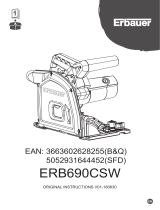
POWX0562 EN
Copyright © 2021 VARO P a g e | 7 www.varo.com
moves freely and does not touch the blade or any other part, in all angles and depths of
cut.
Check the operation and condition of the guard return spring. If the guard and the spring
are not operating properly, they must be serviced before use. Guard may operate
sluggishly due to damaged parts, gummy deposits, or a build-up of debris.
Assure that the guide plate of the saw will not shift while performing the “plunge cut” when
bevel setting is not at 90°. Blade shift sideways will cause binding and likely kick back.
Always observe that the guard is covering the blade before placing saw down on bench or
floor. An unprotected, coasting blade will cause the saw to walk backwards, cutting
whatever is in its path. Be aware of the time it takes for the blade to stop after switch is
released.
Do not unnecessarily burden the machine. Excessive pressure when cutting will damage
the blade quickly. This leads to a reduction in performance of the machine in the
processing and in the cutting accuracy.
7 CAUSES AND PREVENTION OF KICKBACK
A kickback is the sudden reaction as a result of a stuck, jammed or misaligned saw blade
which leads to an uncontrolled saw to be lifted and moved from the workpiece out in the
direction of the operator.
A kickback can occur when the saw blade gets stuck or jammed in the saw gap. The saw
blade is blocked and the motor force repels the circular saw in the direction of the
operator.
A kickback can occur when the saw blade becomes twisted or misaligned in the saw
groove. As a result, the teeth of the back edge of the saw blade can get stuck in the
surface of the workpiece, whereby the saw blade is moved out of the saw gap and the saw
jumps back in the direction of the operator.
A kickback is the result of incorrect or faulty use of the saw. It can be prevented by
appropriate precautions as described below.
Hold the saw firmly with both hands and bring your arms into a position in which you can
resist the kickback forces. Always hold the saw blades on the sides, never bring the blade
in line with your body. In a kickback, the saw can jump backwards, but the operator can
control the kickback forces if appropriate measures were taken.
If the saw blade jams or sawing is interrupted for any reason, release the ON / OFF switch
and calmly hold the saw in the material until the saw blade stands completely still. Never
attempt to remove the saw from the workpiece or pull it backwards as long as the saw
blade is moving or a kickback might occur. Find the cause of the saw blade jam and
eliminate them through appropriate measures.
When you want to restart a saw that is stuck in a workpiece, center the saw blade in the
saw gap and check that the saw teeth are not stuck in the workpiece. If the saw blade
jams, it can move out from the workpiece or a kickback can happen if the saw is restarted.
Prop up large panels in order to minimise the risk of a kickback by a jammed saw blade.
Large panels tend to sag under their own weight. Panels must be supported on both sides,
both in the vicinity of the saw gap as well as on the edge.
Do not use dull or damaged saw blades. Saw blades with blunt or misaligned teeth cause
increased friction, jamming of the saw blade and kickback by an excessively narrow saw
gap.
Tighten the cutting depth position prior to cutting. If the settings change while cutting, the
saw blade can jam and a kickback can occur.
Be especially careful if you perform a "circular cut" in a hidden area, such as an existing
wall. The protruding saw blade can get blocked in hidden objects while cutting and cause
a kickback.













